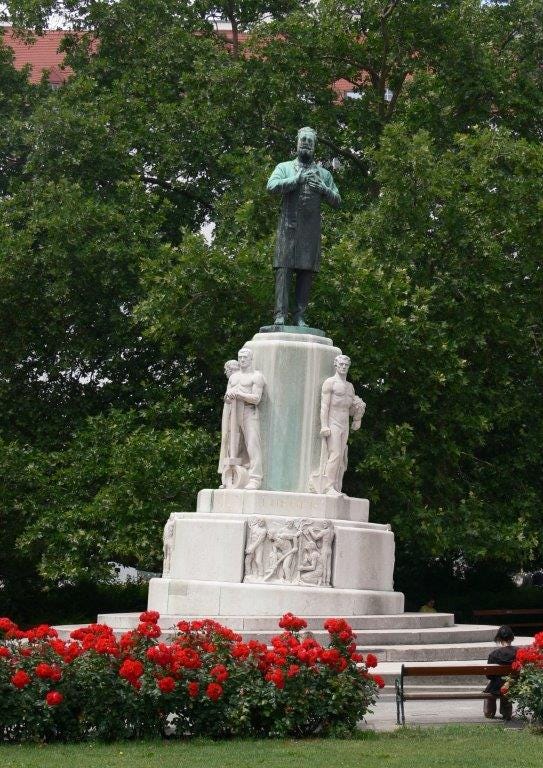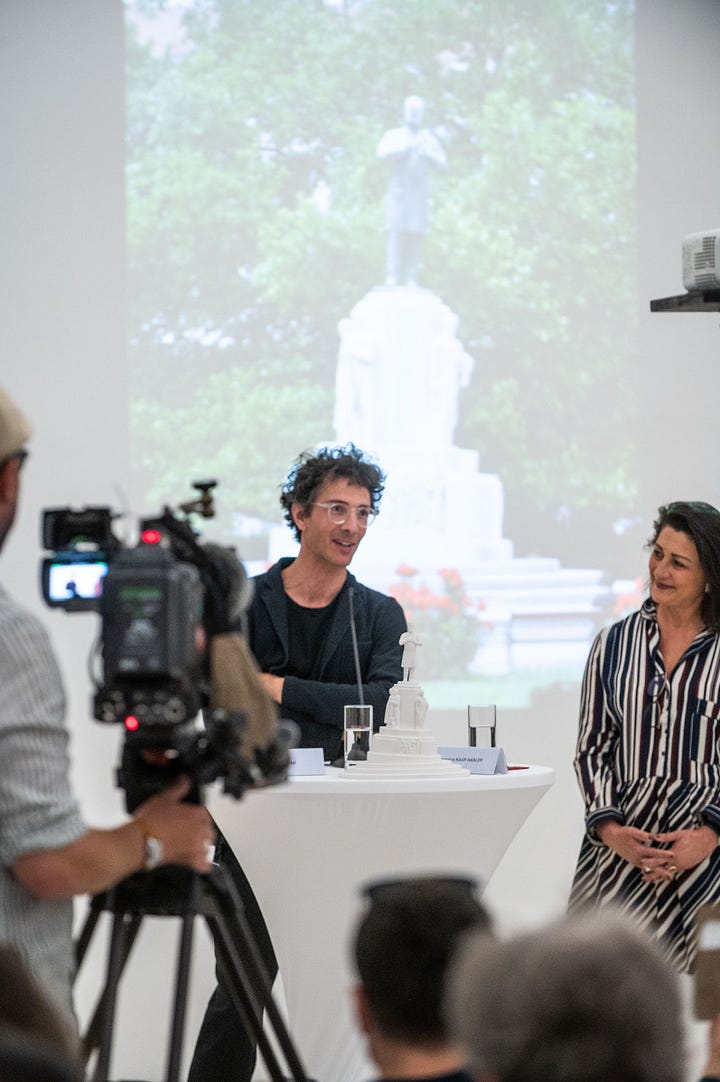The Leaning Tower Of Lueger
Vienna's monument to its former mayor Karl Lueger will be titled 3.5 degrees to the right as part of its planned artistic contextualization


Servus!
At the end of May, Vienna’s monument to its former mayor, the political antisemite Karl Lueger, was defaced once more. Lueger’s towering figure and a large part of the limestone pedestal on which he stands, gazing over his former dominion, was doused in light blue paint by unknown assailants. The Luegerdenkmal has become a palimpsest whose layers of paint, graffiti, and other damage reveal the years of protest and struggle that have taken place there since it was first tagged with the word Schande, shame, in the summer of 2020.
Last year, in response to the cries of ‘shame,’ the City of Vienna made its first attempt to artistically contextualize the monument. That installation, Lueger Temporary, by the Austrian artists Nicole Six and Paul Petritsch, was a failure. It was rightly criticized as an act of colorful bombast—an ugly, cheap carbuncle that, as I wrote back in November, constituted little more than a collage project displaying what the artists learnt in the course of their research into Lueger monuments and neither addressed nor communed with the very monument it was supposed to contextualize.
Lueger Temporary’s life is coming to an end, and earlier this month, the City revealed the winning design for the monument’s permanent contextualization. Schieflage (Karl Lueger 3,5°) by the Viennese artist and musician Klemens Wihlidal will see Lueger cleaned up—the graffiti and other paintwork removed—and tilted 3.5 degrees to the right. Although Wihlidal’s design was first put out into the world in 2010, and in spite of the fact that in the intervening years, our collective understanding of both Lueger and the monument have changed, the competition jury said it did not believe that Schieflage (Karl Lueger 3,5°) had withered with age.
Last week, there was an exhibition of all the entries to the design contest. Walking around the room, it was interesting to observe how few of them proposed a radical alternation to or removal of the monument, opting instead for cosmetic surgery, or addressed the matter at hand in their approaches to contextualization, namely Lueger’s political antisemitism and Catholic and German supremacism. The Lueger Trial would have placed the Lueger statue inside a glass booth akin to that in which Eichmann sat during his trial in Jerusalem—a eye-catching comparison, albeit perhaps a kitsch one. Others would have wrapped the Lueger monument in a zinc shell or erected a counter-monument in its shadow such as one honoring the Austrian Jewish feminist Bertha Pappenheim.
With this in mind, credit must be given to the Schandwache collective’s Forum Against Antisemitism, which would seen the monument removed for a year as part of the design’s implementation, and Milica Tomić’s From Monument to Open Document, which would have altered the official status of the statue and wilded the square. Martin Krenn’s Kein Platz für Antisemitismus, No Place for Antisemitism, would have encircled the statue with a steel wraparound partially obscuring the monument. On one side, the words “Kein Platz für Antisemitismus.” On the other: a timeline of quotations that addressed an aspect of or view on Lueger’s antisemitism. This aspect of Krenn’s design would have needed refining, but it certainly had legs.
This is what could have been. In the end, the jury opted for what may have been, of the all the proposals, the most artistically conservative one. Even if one takes the view that contextualization is the best approach to troublesome monuments or aspects of our history, one would surely have to concede that an opportunity has been missed here to do something truly meaningful or far-reaching at the site of the Luegerdenkmal. Having seen the other entries to the contextualization competition, the outcome cannot help but feel pinched and crabbed by rather narrow artistic and political parameters.
Bis bald!
Thank you for subscribing to the Vienna Briefing. If you know someone who might be interested in receiving this newsletter, consider sharing it with them today.
The Vienna Briefing is a reader-supported publication. If you would like to support my work, think about sending me a tip via PayPal. Thank you to all contributors.
Tempo 100? Not Yet
A majority of Austrians are opposed to reducing the speed limit on the Autobahn from 130 to 100 km/h (81 to 62 mph), although support for the measure is on the rise. Backers of a speed limit reduction argue it would reduce greenhouse gas emissions.
Golden Pia-no
A grand piano with a golden lid that stood in a reception room of Vienna’s renovated parliament building will be removed and replaced by a cheaper model. The controversial golden piano cost parliament €3,000 a month to rent.
All Change, Please
Vienna’s public transport issues could soon be at an end, after a citywide call for new bus and tram operators led to the Wiener Linien having a full quota of apprentice drivers this year. Services reduced last fall due to a lack of staff should be reintroduced this autumn.



